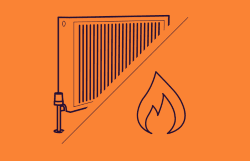Restaurant appliances are essential in the day-to-day operations of any restaurant, but they are also significant energy consumers. According to the Environmental Protection Agency (EPA), the food service industry is one of the most energy-intensive industries in the United States, with restaurants alone accounting for about 1% of the country’s total energy consumption.
This energy usage not only results in high utility bills for restaurant owners but also contributes to the energy efficiency of the food service industry. In this blog post, we will take a closer look at the energy consumption of different restaurant appliances and how to reduce their energy usage.
What appliances that average restaurants use can be energy efficient?
Refrigeration Equipment:
Refrigeration equipment is essential in any commercial kitchen. It includes reach-in and walk-in refrigerators and freezers, under-counter refrigerators, and beverage coolers. Refrigeration equipment consumes a considerable amount of energy, and its energy consumption varies depending on the type and size of the unit. On average, refrigeration equipment accounts for 10-15% of a restaurant’s energy usage. Restaurant owners can reduce energy costs by using more efficient models, performing regular maintenance, and ensuring that the door seals are in good condition.
Commercial Kitchen Cooking Equipment:
Cooking equipment includes ovens, ranges, grills, fryers, and steamers. These food preparation appliances consume a lot of gas and electricity, and their energy usage depends on the appliance’s size and the cooking method. For instance, fryers and grills use more energy than ovens and ranges. On average, cooking equipment accounts for 25-30% of a restaurant’s energy usage. Restaurant owners can reduce their cooking equipment’s energy bills, ensuring that they are the right size for their kitchen, and using the most energy-efficient cooking methods.
Dishwashing Equipment:
Dishwashing equipment is another significant energy consumer in a commercial kitchen. It includes dishwashers, pot washers, and glass washers. Dishwashers consume a considerable amount of energy, with the average dishwasher using 1.2-1.5 kWh of energy per cycle. Dishwashing equipment accounts for 5-10% of a restaurant’s energy usage. To save energy and lower electricity usage, avoiding overloading the dishwasher, and using low-temperature and water-efficient cycles.
Kitchen Lighting:
Lighting is an essential component of any restaurant’s ambiance and design, but it is also a significant energy consumer. Lighting accounts for 10-15% of a restaurant’s energy usage. By using energy-efficient light bulbs and fixtures, installing motion sensors and timers, and ensuring that their lighting is only used when necessary, a catering business can reduce the average per kWh usage, lower their carbon footprint and have an impact on the catering industry.
HVAC Systems:
HVAC systems are responsible for heating, ventilation, and air conditioning in a restaurant. HVAC systems account for 30-40% of a restaurant’s energy usage. To reduce operating costs, business gas and electricity bills, businesses should ensure that their HVAC system is the right size for their restaurant, regularly cleaning or replacing air filters, and using programmable thermostats.
How much energy consumption by restaurant appliances?
- Griddles: Griddles are a common appliance in many restaurants and can consume a lot of energy. The energy usage depends on the size of the griddle, but on average, a 36-inch griddle can use up to 4.8 kW per hour.
- Deep Fryers: Deep fryers are another common appliance in restaurants and use a lot of energy. The energy usage depends on the size of the fryer and how often it’s used, but on average, a 50-pound fryer can use up to 4.5 kW per hour.
- Convection Ovens: Convection ovens are popular in many restaurants because they cook food quickly and evenly. The energy usage of a convection oven depends on the size of the oven and how often it’s used, but on average, a commercial convection oven can use up to 3.5 kW per hour.
- Steamers: Steamers are commonly used in restaurants to cook vegetables and seafood. The energy usage of a steamer depends on the size of the steamer and how often it’s used, but on average, a commercial steamer can use up to 2.5 kW per hour.
- Ice Machines: Ice machines are essential in restaurants, but they can be energy-intensive. The energy usage of an ice machine depends on the size of the machine and how often it’s used, but on average, a commercial ice machine can use up to 1.5 kW per hour.
How to improve energy efficiency and reduce restaurant energy consumption
Restaurants consume a significant amount of energy, and this results in high utility bills. However, there are ways to improve energy efficiency and reduce energy consumption in restaurants. Here are some tips that can help you achieve that:
Upgrade your lighting to lower energy costs
Replace your traditional light bulbs with energy-efficient LEDs. LED bulbs last longer and consume less energy, reducing your electricity bills. Additionally, consider installing occupancy sensors or timers to turn off lights when not in use.
Use energy-efficient appliances to stop utility costs
When shopping for new appliances, look for those with an ENERGY STAR rating. ENERGY STAR-certified appliances use less energy and water compared to their conventional counterparts, resulting in lower utility bills.
Implement a preventive maintenance business energy program
Regular maintenance of your equipment can improve energy efficiency, reduce downtime and extend the lifespan of your appliances. Maintenance tasks such as cleaning coils and replacing air filters can help your equipment run more efficiently, reducing energy consumption.
Optimize your HVAC system to reduce operating costs
Heating, ventilation, and air conditioning (HVAC) systems are responsible for a significant portion of restaurant energy consumption. Make sure your HVAC system is properly maintained, and the air filters are regularly replaced to improve airflow and energy efficiency. You can also consider installing a programmable thermostat to regulate temperature settings and reduce energy waste.
Insulate your building to lower energy bills
Insulation helps keep your building cool in the summer and warm in the winter, reducing the workload on your HVAC system. Insulate your building’s walls, ceiling, and floor to improve energy efficiency and reduce energy consumption.
Educate your staff to save energy
Your staff can play a significant role in reducing energy consumption in your restaurant. Educate them on energy-saving practices such as turning off lights and appliances when not in use, and encourage them to report any energy wastage.




